Waste Biomass Originated Biocompatible Fluorescent Graphene Nano-Sheets for Latent Fingerprints Detection in Versatile Surfaces
Abstract
1. Introduction
2. Results
2.1. Synthesis and Characterization of the Synthesized GNS
2.2. Characterization of GNS
2.2.1. Morphological Characterization
2.2.2. Structural Characterization
2.2.3. Optical Characterization
2.3. Biocompatibility/Toxicity Measurements
2.4. Antimicrobial Spectrum of GNS
2.4.1. Inhibitory Effects of GNSs on B. cereus Cell Growth Kinetics
2.4.2. Fluorescence Staining
2.5. Development of Quiescent Finger Impressions Using GNS
2.6. Development of Latent Fingerprints by Using GNS
3. Materials and Methods
3.1. Chemicals and Reagents
3.2. Sample Collection
3.3. Synthesis of Graphene Nano-Sheets (GNS)
3.4. Characterization of Synthesized GNSs
3.5. Cell Lines Experiments for Cytotoxicity and Morphological Evaluation of GNSs
3.6. Bacterial Strain and Antibacterial Efficiency of GNSs
3.6.1. Antibacterial and Bacteria-Killing Kinetics of GNSs
3.6.2. Fluorescence Microscopy Staining Assays for Live/Dead Bacterial Cells
3.7. Application of GNSs for Detection of Fingerprints
4. Discussion
5. Conclusions
Author Contributions
Funding
Acknowledgments
Conflicts of Interest
References
- Li, H.; Zhang, C.; Wang, J.; Chong, H.; Zhang, T.; Wang, C. Pristine Graphic Carbon Nitride Quantum Dots for the Visualized Detection of Latent Fingerprints. Anal. Sci. 2021, 37, 1497–1503. [Google Scholar] [CrossRef] [PubMed]
- Hawthorne, M. Fingerprints: Analysis and Understanding; CRC Press: Boca Raton, FL, USA, 2017. [Google Scholar]
- Boone, L.L. Fingerprints. In Manual of Crime Scene Investigation; CRC Press: Boca Raton, FL, USA, 2023; pp. 181–192. [Google Scholar]
- Das, G.S.; Hwang, J.Y.; Jang, J.H.; Tripathi, K.; Kim, T.Y. Biomass based functionalized graphene for self rechargable zincair batteries. ACS Appl. Energy Mater. 2022, 5, 6663–66705. [Google Scholar] [CrossRef]
- Hutchins, L.A. Systems of Friction Ridge Classification; U.S. Department of Justice: Washington, DC, USA, 2007. [Google Scholar]
- Zhao, D.; Ma, W.; Xiao, X. The Recognition of Sweat Latent Fingerprints with Green-Emitting Carbon Dots. Nanomaterials 2018, 8, 612. [Google Scholar] [CrossRef] [PubMed]
- Prabakaran, E.; Pillay, K. Nanomaterials for Latent Fingerprint Detection—A Review. J. Mater. Res. Technol. 2021, 12, 1856–1885. [Google Scholar] [CrossRef]
- Sawhney, S.; Bhati, K.; Chhabra, P.; Tripathy, D. Role of Nanotechnology in Techniques in Fingerprints Enhancement. Indian J. Forensic Med. Pathol. 2021, 14, 288–294. [Google Scholar] [CrossRef]
- Abebe, B.; Chowdappa, H.; Murthy, A.; Zereffa, E.A.; Dessie, Y. Latent Fingerprint Enhancement Techniques: A Review. J. Chem. Rev. 2020, 2, 40–56. [Google Scholar] [CrossRef]
- Bhati, K. Role of Nanoparticles in Latent Fingerprinting: An Update. Lett. Appl. NanoBioSci. 2020, 9, 1427–1443. [Google Scholar] [CrossRef]
- Bhati, K.; Tripathy, D.; Chhabra, P. Role of Fluorescent Substances in Development of Latent Fingerprints: A Review. Indian J. Forensic Med. Pathol. 2021, 14, 351–358. [Google Scholar]
- Yang, L.; Zhang, Q.; Han, Y.; Li, H.; Sun, S.; Xu, Y. The Selective Deprotonation of Carbon Quantum Dots for Fluorescence Detection of Phosphate and Visualization of Latent Fingerprints. Nanoscale 2021, 13, 13057–13064. [Google Scholar] [CrossRef]
- Zhang, Q.; Zhao, Q.; Fu, M.; Fan, X.; Lu, H.; Wang, H.; Zhang, Y.; Wang, H. Carbon Quantum Dots Encapsulated in Super Small Platinum Nanocrystals Core-Shell Architecture/Nitrogen Doped Graphene Hybrid Nanocomposite for Electrochemical Biosensing of DNA Damage Biomarker-8-Hydroxy-2′-Deoxyguanosine. Anal. Chim. Acta 2019, 1047, 9–20. [Google Scholar] [CrossRef]
- Wang, H.-J.; Hou, W.-Y.; Yu, T.-T.; Chen, H.-L.; Zhang, Q.-Q. Facile Microwave Synthesis of Carbon Dots Powder with Enhanced Solid-State Fluorescence and Its Applications in Rapid Fingerprints Detection and White-Light-Emitting Diodes. Dye. Pigment. 2019, 170, 107623. [Google Scholar] [CrossRef]
- Verhagen, A.; Kelarakis, A. Carbon Dots for Forensic Applications: A Critical Review. Nanomaterials 2020, 10, 1535. [Google Scholar] [CrossRef]
- Fernandes, D.; Krysmann, M.J.; Kelarakis, A. Carbon Dot Based Nanopowders and Their Application for Fingerprint Recovery. Chem. Commun. 2015, 51, 4902–4905. [Google Scholar] [CrossRef] [PubMed]
- Chen, J.; Wei, J.-S.; Zhang, P.; Niu, X.-Q.; Zhao, W.; Zhu, Z.-Y.; Ding, H.; Xiong, H.-M. Red-Emissive Carbon Dots for Fingerprints Detection by Spray Method: Coffee Ring Effect and Unquenched Fluorescence in Drying Process. ACS Appl. Mater. Interfaces 2017, 9, 18429–18433. [Google Scholar] [CrossRef]
- Tang, M.; Ren, G.; Zhu, B.; Yu, L.; Liu, X.; Chai, F.; Wu, H.; Wang, C. Facile Synthesis of Orange Emissive Carbon Dots and Their Application for Mercury Ion Detection and Fast Fingerprint Development. Anal. Methods 2019, 11, 2072–2081. [Google Scholar] [CrossRef]
- Das, G.S.; Bhatnagar, A.; Pirila, P.Y.; Tripathi, K.M.; Kim, T.Y. Sustainable nitrogen-doped functionalized graphene nanosheets for visible-light-induced photocatalytic water splitting. Chem. Commun. 2020, 56, 6953. [Google Scholar] [CrossRef] [PubMed]
- Aggarwal, R.; Sonkar, S.K.; Tripathi, K.M. Visible-light promoted hydrogen production by diesel soot derived onion like carbon nanoparticles. Carbon 2023, 208, 436–442. [Google Scholar] [CrossRef]
- Kaushik, J.; Tripathi, K.M.; Singh, R.; Sonkar, S.K. Thiourea-functionalized graphene aerogel for the aqueous phase sensing of toxic Pb(II) metal ions and H2O2. Chemosphere 2022, 287, 132105. [Google Scholar] [CrossRef]
- Kumari, P.; Tripathi, K.M.; Awasthi, K.; Gupta, R. Sustainable carbon nano-onions as an adsorbent for the efficient removal of oxo-anions. Environ. Sci. Pollut. Res. 2023, 30, 15480–15489. [Google Scholar] [CrossRef]
- Chowdhury, S.N.; Tung, T.T.; Hoai, Q.T.; Castro, M.; Feller, J.F.; Sonkar, S.K.; Tripathi, K.M. Upgrading of diesel engine exhaust waste into onion-like carbon nanoparticles for integrated degradation sensing in nano-biocomposites. New J. Chem. 2021, 45, 3675–3682. [Google Scholar] [CrossRef]
- Jung, S.H.; Huong, P.T.; Sahani, S.; Tripathi, K.M.; Park, B.J.; Han, Y.H.; Kim, T.Y. Biomass-Derived Graphene-Based Materials Embedded with Onion-Like Carbons for High Power Supercapacitors. J. Electrochem. Soc. 2022, 169, 010509. [Google Scholar] [CrossRef]
- Das, G.S.; Sarkar, S.; Aggarwal, R.; Sonkar, S.K.; Park, J.W.; Tripathi, K.M.; Kim, T.Y. Fluorescent microspheres of zinc 1,2-dicarbomethoxy-1,2-dithiolate complex decorated with carbon nanotubes. Carbon Lett. 2019, 29, 595–603. [Google Scholar] [CrossRef]
- Dhiman, N.; Ghosh, S.; Mishra, Y.M.; Tripathi, K.M. Prospects of nano-carbons as emerging catalysts for enzyme-mimetic applications. Mater. Adv. 2022, 3, 3101–3122. [Google Scholar] [CrossRef]
- Qu, S.; Wang, X.; Lu, Q.; Liu, X.; Wang, L. A Biocompatible Fluorescent Ink Based on Water-Soluble Luminescent Carbon Nanodots. Angew. Chem. Int. Ed. 2012, 51, 12215–12218. [Google Scholar] [CrossRef] [PubMed]
- Nugroho, D.; Oh, W.C.; Chanthai, S.; Benchawattananon, R. Improving Minutiae Image of Latent Fingerprint Detection on Non-Porous Surface Materials under UV Light Using Sulfur Doped Carbon Quantum Dots from Magnolia Grandiflora Flower. Nanomaterials 2022, 12, 3277. [Google Scholar] [CrossRef]
- Gomes, S.A.O.; Vieira, C.S.; Almeida, D.B.; Santos-Mallet, J.R.; Menna-Barreto, R.F.S.; Cesar, C.L.; Feder, D. CdTe and CdSe Quantum Dots Cytotoxicity: A Comparative Study on Microorganisms. Sensors 2011, 11, 11664–11678. [Google Scholar] [CrossRef]
- Weng, M.; Sun, L.; Qu, S.; Chen, L. Fingerprint-inspired graphene pressure sensor with wrinkled structure. Extrem. Mech. Lett. 2020, 37, 100714. [Google Scholar] [CrossRef]
- Zhang, M.; Zhu, Y.; Yu, X.; Liu, S.; Wang, M.; Wei, Q.; Hu, X.; Tang, Q.; Zhao, Y.; Zhang, X. Application of Electrodepositing Graphene Nanosheets for Latent Fingerprint Enhancement. Electroanalysis 2014, 26, 209–215. [Google Scholar] [CrossRef]

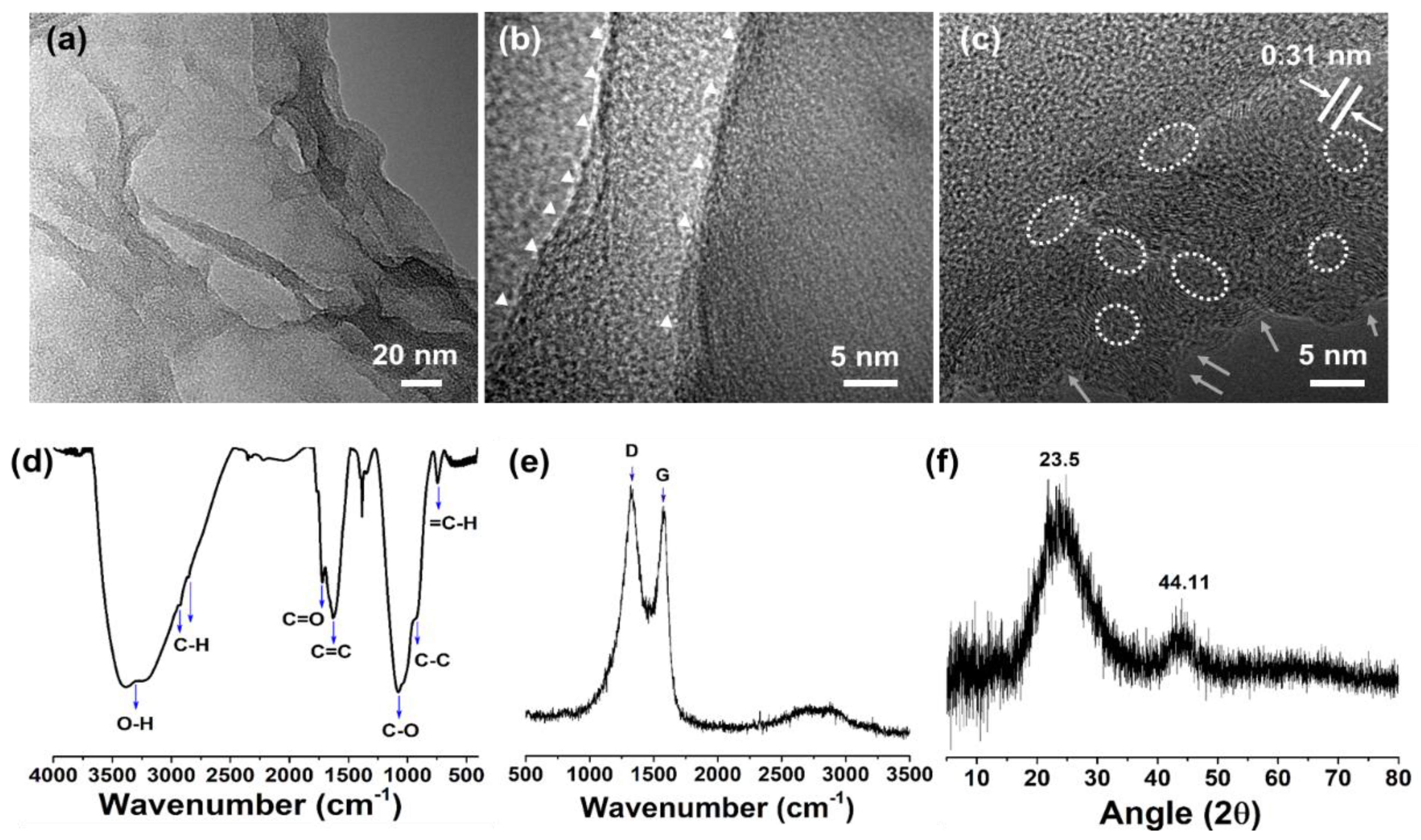

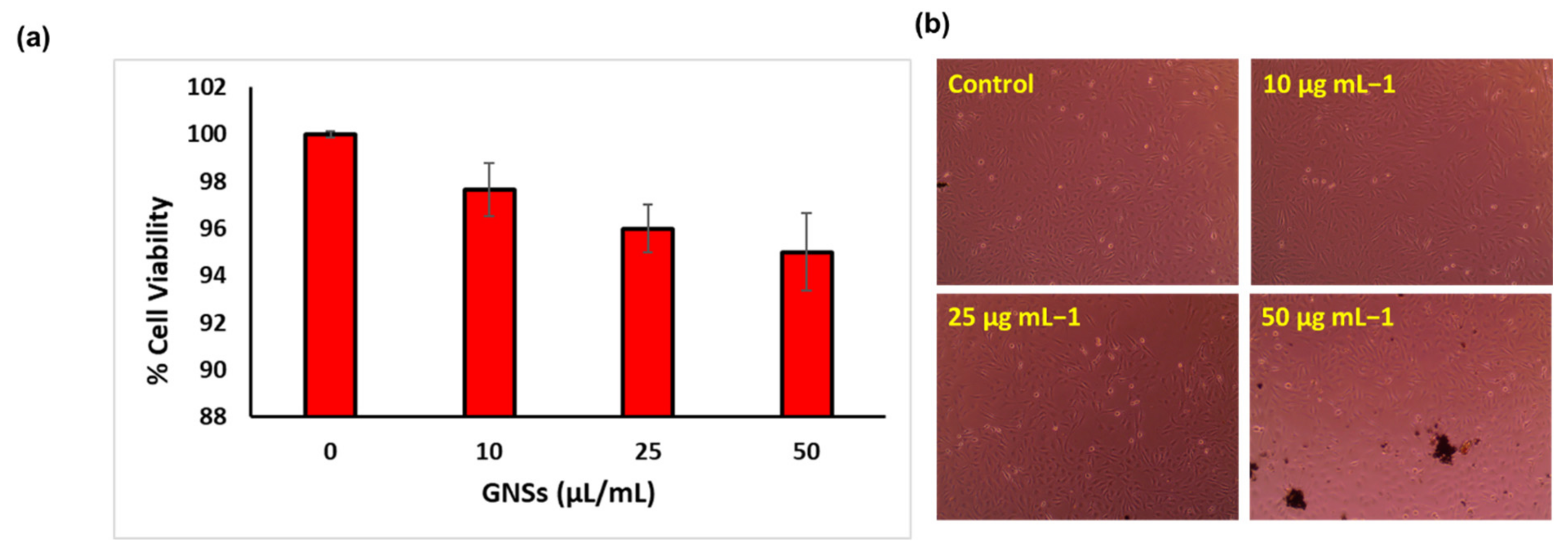
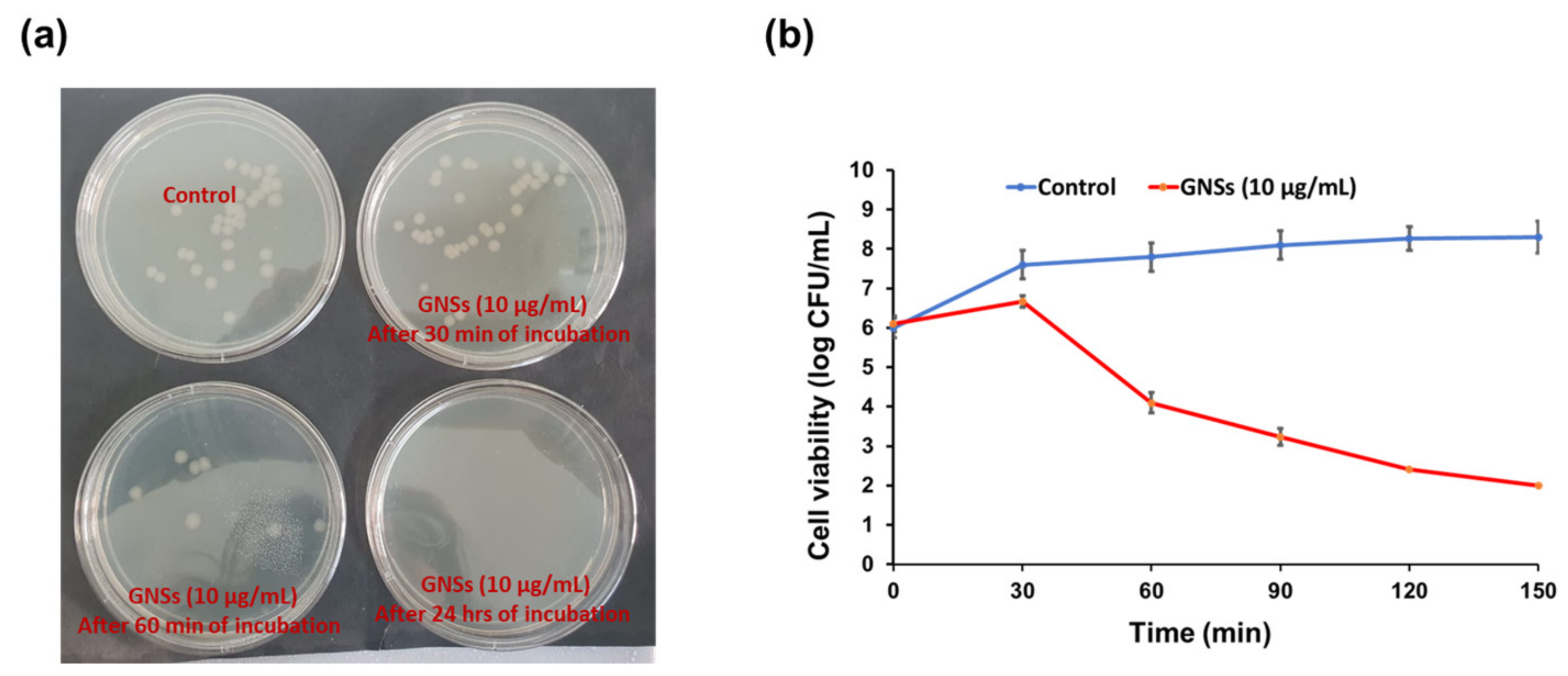



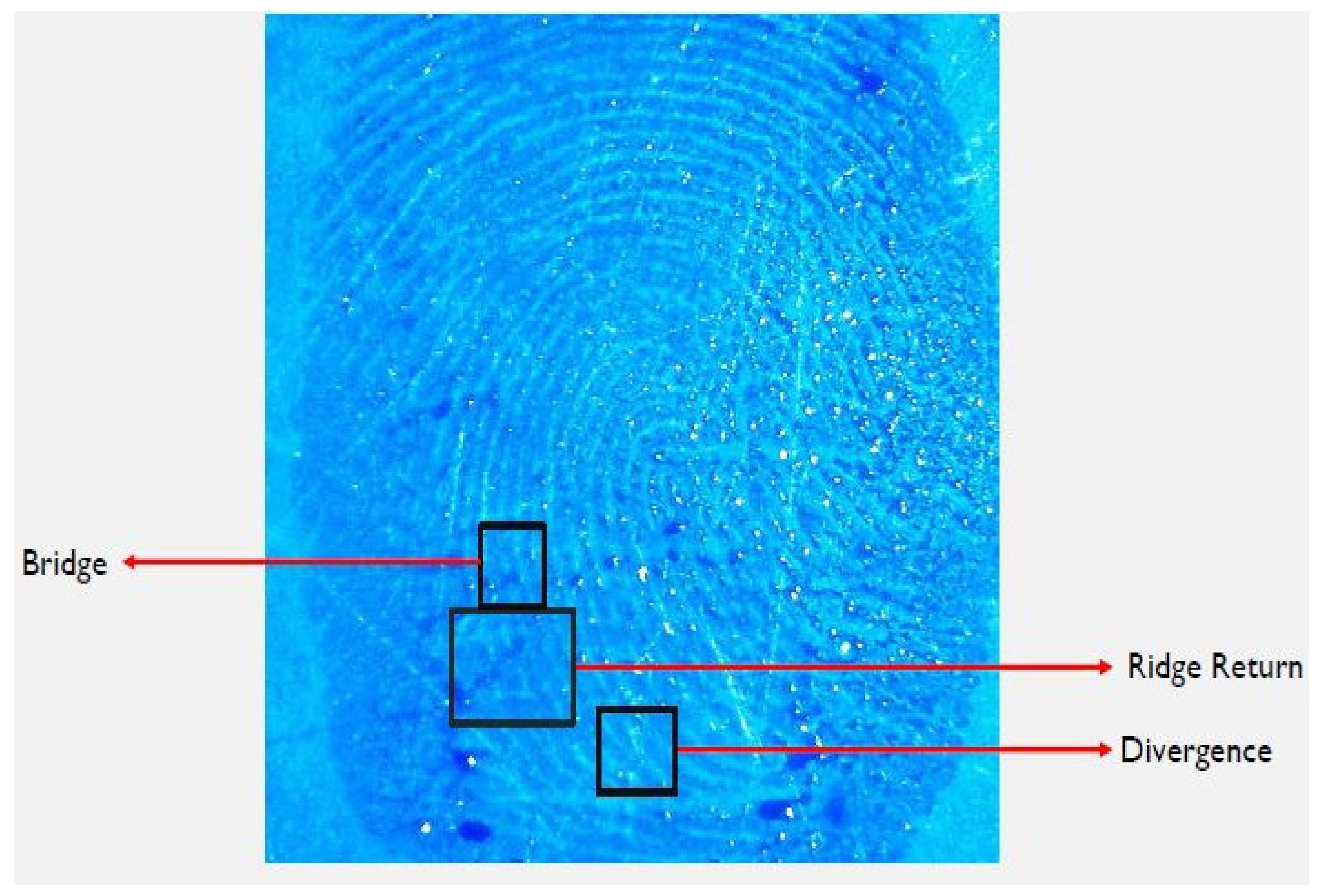
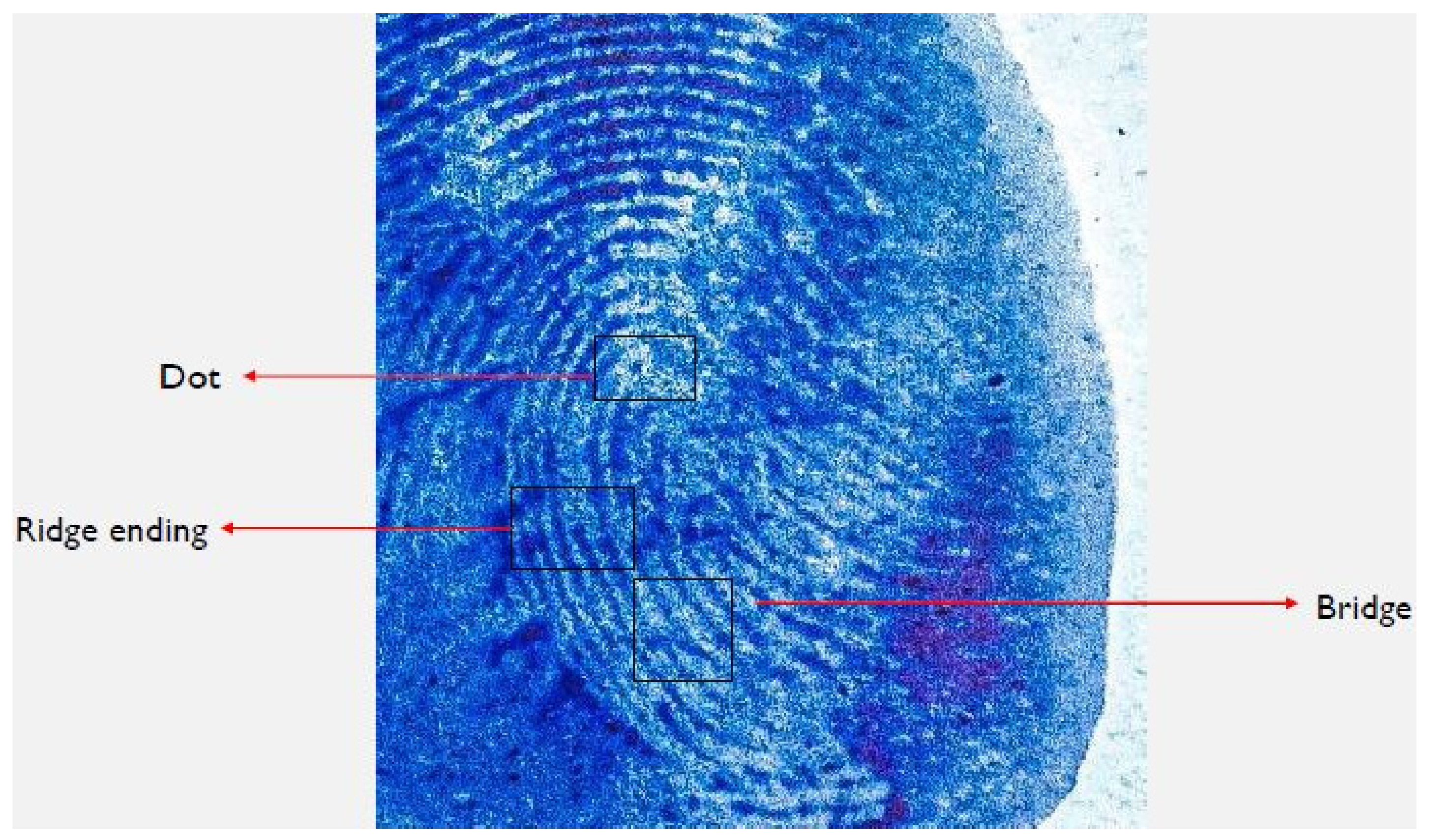
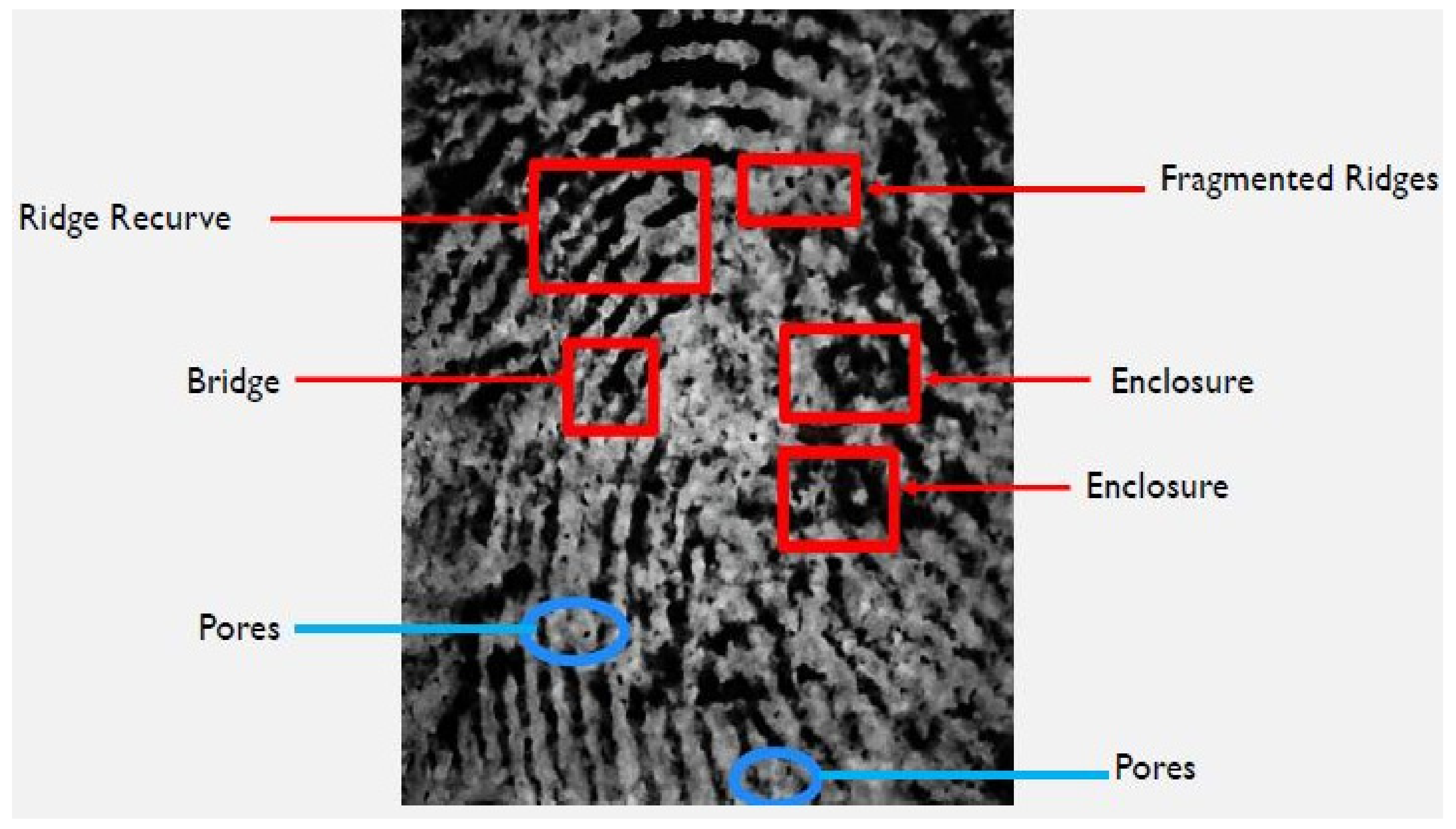
| S.No. | Nanoparticle | Surface | Material | Level-I (Pattern) | Level-II (Ridge Characteristics) |
|---|---|---|---|---|---|
| 1. | GNS | NON-POROUS | Glass slide | Visible | Visible |
| 2. | GNS | NON-POROUS | Marble surface | Visible | Visible |
| 3. | GNS | NON-POROUS | Plastic surface | Visible | Visible |
| 4. | GNS | NON-POROUS | Stainless steel | Visible | Visible |
| 5. | GNS | POROUS | Paper | Visible | Visible |
Disclaimer/Publisher’s Note: The statements, opinions and data contained in all publications are solely those of the individual author(s) and contributor(s) and not of MDPI and/or the editor(s). MDPI and/or the editor(s) disclaim responsibility for any injury to people or property resulting from any ideas, methods, instructions or products referred to in the content. |
© 2023 by the authors. Licensee MDPI, Basel, Switzerland. This article is an open access article distributed under the terms and conditions of the Creative Commons Attribution (CC BY) license (https://creativecommons.org/licenses/by/4.0/).
Share and Cite
Bhati, K.; Tripathy, D.B.; Dixit, A.K.; Kumaravel, V.; Sabir, J.S.M.; Rather, I.A.; Shukla, S. Waste Biomass Originated Biocompatible Fluorescent Graphene Nano-Sheets for Latent Fingerprints Detection in Versatile Surfaces. Catalysts 2023, 13, 1077. https://doi.org/10.3390/catal13071077
Bhati K, Tripathy DB, Dixit AK, Kumaravel V, Sabir JSM, Rather IA, Shukla S. Waste Biomass Originated Biocompatible Fluorescent Graphene Nano-Sheets for Latent Fingerprints Detection in Versatile Surfaces. Catalysts. 2023; 13(7):1077. https://doi.org/10.3390/catal13071077
Chicago/Turabian StyleBhati, Kajol, Divya Bajpai Tripathy, Ashutosh Kumar Dixit, Vignesh Kumaravel, Jamal S.M. Sabir, Irfan A. Rather, and Shruti Shukla. 2023. "Waste Biomass Originated Biocompatible Fluorescent Graphene Nano-Sheets for Latent Fingerprints Detection in Versatile Surfaces" Catalysts 13, no. 7: 1077. https://doi.org/10.3390/catal13071077
APA StyleBhati, K., Tripathy, D. B., Dixit, A. K., Kumaravel, V., Sabir, J. S. M., Rather, I. A., & Shukla, S. (2023). Waste Biomass Originated Biocompatible Fluorescent Graphene Nano-Sheets for Latent Fingerprints Detection in Versatile Surfaces. Catalysts, 13(7), 1077. https://doi.org/10.3390/catal13071077









